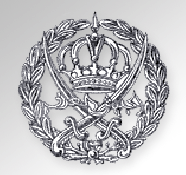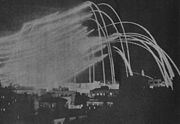| Arab Legion (الجيش العربي) | |
|---|---|
| الجيش العربي | |
 Arab Legion insignia | |
| Active | 22 October 1920 - 25 March 1956 |
| Country | Jordan |
| Allegiance |
Hashemite Kingdom of Jordan Emirate of Transjordan |
| Type | Army |
| Size |
150 (in 1920) 12,000 (in 1949) 22,000 (in 1956) |
| Garrison/HQ | Zarqa |
| Patron | Monarch |
| Anniversaries |
10 June 1917: Arab Revolt 22 October 1920: Establishment of the Arab Legion 25 May 1956: Dismissal of British officers |
| Engagements |
Syria-Lebanon Campaign (1941) Anglo-Iraqi War (1941) Battles of Latrun (1948) Battles of Jerusalem (1948) |
| Commanders | |
| (1920-1939) | Captain Frederick Gerard Peake |
| Ceremonial chief | General John Bagot Glubb |
| Notable commanders | Colonel JW Hackett, Jr |
The Arab Legion (al-Jaysh al-Arabī) was the regular army of Transjordan and then Jordan in the early part of the 20th century.
Creation[]
In October 1920, after taking over the Transjordan region, the United Kingdom formed a unit of 150 men called the "Mobile Force" under the command of Captain Frederick Gerard Peake to defend the territory against both internal and external threats.[1] The Legion was based in Zarqa and 80 percent of its men were the local Chechens.[2]

Arab army during the Arab revolt of 1916 against the Ottoman Empire formed the nucleus of the Arab Legion

Arab Legion in Iraq during the Anglo-Iraqi War in 1941
It was quickly expanded to 1,000 men recruiting Arabs who had served in the military of the Ottoman Empire. On 22 October 1923, the police were merged with the Reserve Mobile Force, still under Peake, who was now an employee of the Emirate of Transjordan. The new force was named Al Jeish al Arabi (the Arab Army) but was always known officially in English as the Arab Legion. The Arab Legion was financed by Britain and commanded by British officers.[3] The force was formed as a police force to keep order among the tribes of Transjordan and to guard the important Jerusalem–Amman road.
On 1 April 1926, the Transjordan Frontier Force was formed from cadre drawn from the Arab Legion. It consisted of only 150 men and most of them were stationed along Transjordan's roads. During this time the Arab Legion was reduced to 900 men and was also stripped of its machine guns, artillery, and communications troops.
In 1939, John Bagot Glubb, better known as Glubb Pasha, became the Legion's commander along with Major General Abdul Qadir Pasha Al Jundi as his deputy commander both transformed it into the best-trained Arab army.
World War II[]
During World War II, the Arab Legion took part in the British war effort against pro-Axis forces in the Mediterranean and Middle East Theatre. By then the force had grown to 1,600 men.
The Legion, part of Iraqforce, contributed significantly in the Anglo-Iraqi War and in the Syria-Lebanon campaign, the two decisive early victories for the Allies.
Top three high-ranking officers representative of Legion participated in the Victory March as follows: ◦Major General Abdul Qadir Pasha el Jundi, O.B.E. ◦Colonel Bahjat Bey Tabbara. ◦Lieutenant Colonel Ahmed Sudqui Bey, M.B.E.
1948 Arab-Israeli War[]

Arab Legion commander Abdullah el Tell (far right) with Captain Hikmat Mihyar (far left) pose with Jewish prisoners after the Fall of Gush Etzion

Arab Legion artillery shells illuminate Jerusalem in 1948
The Arab Legion actively participated in the 1948 Arab-Israeli war. With a total strength of just over 6,000, the Arab Legion's military contingent consisted of 4,500 men in four single battalion-sized regiments, each with their own armored car squadrons, and seven independent companies plus support troops. The regiments were organized into two brigades. 1st Brigade contained 1st and 3rd Regiments while 3rd brigade contained 2nd and 4th Regiments. There were also two artillery batteries with four 25-pounders each. On 9 February 1948 the Transjordan Frontier Force was disbanded with members being absorbed back into the Arab Legion. Although headed by Glubb, now a Lieutenant General, command in the field was by Brigadier Norman Lash.
The Legion was initially withdrawn from Palestine to Transjordanian territory, under instruction from the United Nations, prior to the end of the British Mandate. With the commencement of hostilities the Legion re-entered Palestine with 1st Brigade heading to Nablus and 2nd Brigade heading to Ramallah. The Arab Legion entered Palestine with other Arab Forces on May 15, 1948 using the Allenby, now King Hussein, bridge as they were advancing to cover the approaches from Jenin, in the north to Alaffoula and from Al-Majame'a bridge on the Jordan River to Bissan Alaffoula.
There was considerable embarrassment from the UK government that British officers were employed in the Legion during the conflict and so they, including a brigade commander, were instructed to return to Transjordan. This led to the bizarre spectacle of British officers leaving their units to return to Transjordan before sneaking back across the border to rejoin the Arab Legion. Without exception all of the affected officers returned to their units.[citation needed] One British MP called for Glubb Pasha to be imprisoned for serving in a foreign army without the King's permission.
A few days before the war, Legion troops were involved in the Kfar Etzion massacre. At Latrun, the Legion blockaded the Jerusalem highway. The Legion also secured the West Bank for Transjordan.
Units of the Arab Legion were engaged in several battles with the Jewish forces including the following:
- Kfar Etzion massacre from 10 to 13 May 1948.
- Battles of Latrun from 20 May to 18 July 1948.
- Siege of Jerusalem from 17 May to 18 July 1948.
On 9 February 1948 the 3,000 strong Trans-Jordan Frontier Force was disbanded with members being absorbed back into the Arab Legion. By the wars end in 1949, the Arab Legion consisted of over 10,000 men manning a 100-mile front, which then expanded to a 400-mile front following the withdraw of Iraqi forces.
Further clashes with Israel[]

Vickers VC.1 Viking of the Arab Legion Air Force in 1955
On September 11, 1956, an Israeli force in what the IDF termed one of its retribution operations, Operation Jonathan, raided Jordanian territory at Al-Rahwa, Hebron Sector, attacking the police station and clashing with a unit from the Legion's Desert Force. Over twenty soldiers and policemen were killed.[4]
In another raid on October 10, 1956, an Israeli force, estimated at a motorized infantry brigade, supported by medium-range artillery and combat aircraft, attacked the towns of Hubla, Al-Nabi Illias and Azroun. The assaulting troops fought the Arab legion west of Al-Nabi Illias. One hundred Jordanian soldiers and 17 IDF soldiers were killed during the operation.[citation needed]
The Legion generally stayed out of the 1956 Suez Crisis.
Jordanian army[]
On 1 March 1956, the Legion was renamed as the Arab Army (now Jordanian Armed Forces). In Israel, the Hebrew term "Ligioner" (ליגיונר), i.e. "Legionary" was still informally used for Jordanian soldiers for many years afterwards, also at the time of the 1967 war and its aftermath.
Commanders[]

King Abdullah I with John Bagot Glubb "Glubb Pasha"
- Colonel Frederick Peake ("Peake Pasha") - 22 October 1923 - 21 March 1939
- Lt. Colonel Ernest Stafford ("Stafford Bey") 2nd IC—1924-1931.
- Lieutenant General John Glubb, KCB, CMG, DSO, OBE, MC ("Glubb Pasha") - 21 March 1939 - 1 March 1956
- Major General Abdul Qadir Pasha Al Jundi, O.B.E. ("Abdul Qadir Pasha")
Note: "Pasha" is a Turkish honorary title in one of its various ranks is equivalent to the British title of "Lord", and Bey is equivalent to "Sir".
See also[]
- Hadassah medical convoy massacre
References[]
- ↑ Kenneth Pollack, Arabs at War, Council on Foreign Relations/University of Nebraska Press, 2002, p.267
- ↑ http://www.globalsecurity.org/military/library/news/2000/01/chechen98/261.htm
- ↑ Avi Shlaim (2007), Lion of Jordan: The Life of King Hussein in War and Peace, Allen Lane, ISBN 978-0-7139-9777-4, p.17
- ↑ Morris, Benny (1993) Israel's Border Wars, 1949 - 1956. Arab Infiltration, Israeli Retaliation, and the Countdown to the Suez War. Oxford University Press, ISBN 0-19-827850-0. Page 392.
Bibliography[]
- Dupuy, Trevor N, Elusive Victory, The Arab-Israeli Wars, 1947–1974, Hero (1984)
- Farndale, Sir Martin, History of the Royal Regiment of Artillery, The Years of Defeat, 1939–41, Brassey’s (1996)
- Glubb, John Bagot, The Arab Legion, Hodder & Stoughton, London (1948)
- A. Isseroff, Kfar Etzion Remembered: A History of Gush Etzion and the Massacre of Kfar Etzion, 2005.
- I. Levi, Jerusalem in the War of Independence ("Tisha Kabin" – Nine Measures – in Hebrew) Maarachot – IDF, Israel Ministry of Defence, 1986. ISBN 965-05-0287-4
- Pal, Dharm, Official History of the Indian Armed in the Second World War, 1939-45 - Campaign in Western Asia, Orient Longmans (1957)
- Roubicek, Marcel, Echo of the Bugle, extinct military and constabulary forces in Palestine and Trans-Jordan 1915, 1967, Franciscan (Jerusalem 1974)
- Avi Shlaim (2007). Lion of Jordan: The Life of King Hussein in War and Peace, Allen Lane. ISBN 978-0-7139-9777-4
- P.J. Vatikiotis, (1967). Politics and the Military in Jordan: A Study of the Arab Legion, 1921-1957, New York, Praeger Publishers. ISBN
- The Arab Legion (Men-at-arms) (Paperback) by Peter Young, 48 pages, Osprey Publishing (15 Jun 1972) ISBN 0-85045-084-5 and ISBN 978-0-85045-084-2
- Jordan – A Country Study, U.S. Library of Congress
External links[]
- Encyclopædia Britannica article
- The Arab Legion
- The Arab Legion and the Defense of Jerusalem
- 1956 - King of Jordan sacks British general (BBC article and video)
| ||||||||||||||
The original article can be found at Arab Legion and the edit history here.